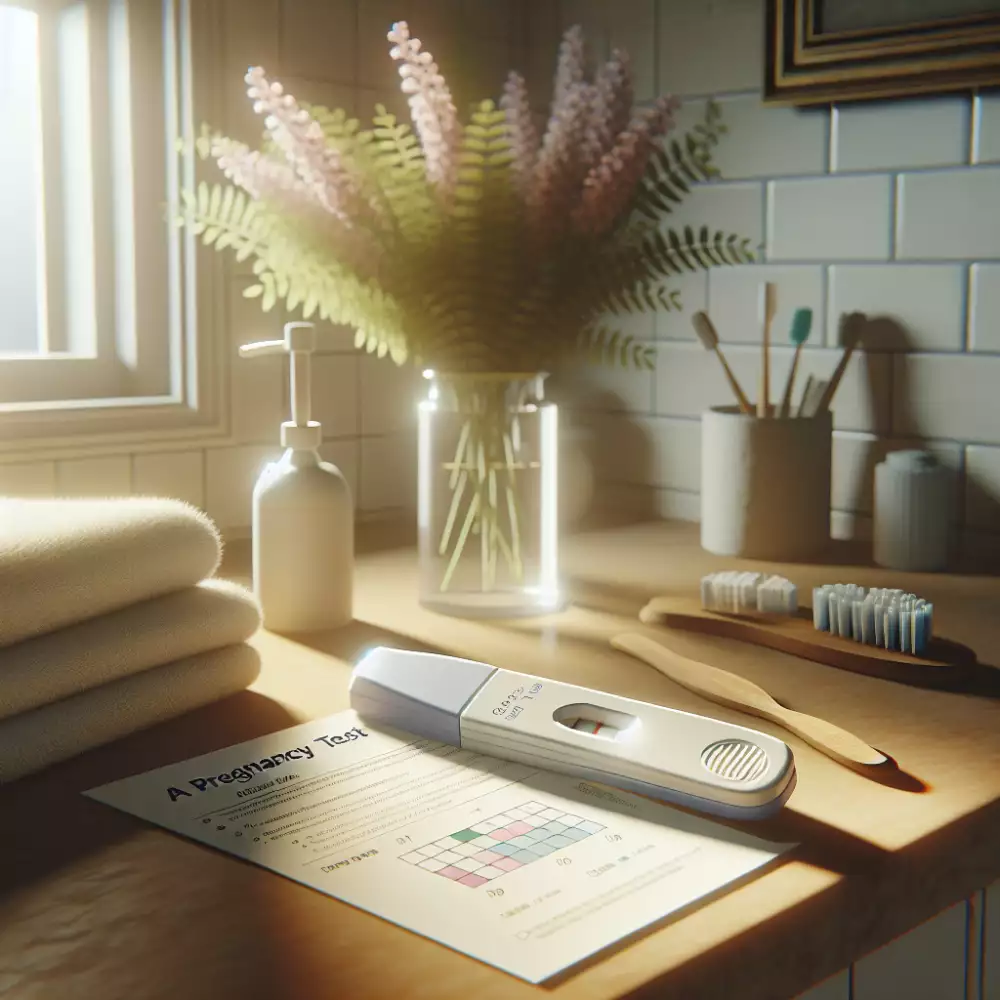Amniotic Fluid Leak? How to Test At Home

Amniotic Fluid Leak
During pregnancy, your baby grows and develops inside a fluid-filled sac called the amniotic sac. The fluid inside, amniotic fluid, cushions your baby and helps with development. Sometimes, this sac can tear or leak, leading to a condition known as amniotic fluid leak.
If you suspect an amniotic fluid leak, it's crucial to contact your healthcare provider immediately. While there are no reliable at-home tests to definitively diagnose an amniotic fluid leak, some methods can help you decide whether to seek medical advice:
Monitoring Discharge: Pay close attention to any unusual vaginal discharge. Amniotic fluid is typically clear and odorless, although it may sometimes contain traces of blood or mucus. Unlike urine, it doesn't have a strong ammonia smell. If you notice a gush of fluid or a continuous trickle that's different from your usual discharge, it's essential to contact your doctor.
Checking for Color Changes: After going to the bathroom, wipe yourself from front to back with a clean, white piece of toilet paper. Examine the paper for any signs of amniotic fluid.
Observing for Other Symptoms: Along with fluid leakage, be aware of other potential signs of an amniotic fluid leak, such as lower abdominal cramping, back pain, or a decrease in your baby's movements.
Remember, these at-home observations are not a substitute for professional medical evaluation. If you suspect an amniotic fluid leak, it's vital to contact your healthcare provider promptly. They can perform tests, such as a sterile speculum examination, a nitrazine test, or an amniotic fluid index (AFI) ultrasound, to confirm or rule out an amniotic fluid leak and provide appropriate guidance and care.
Importance of Home Testing
Knowing if your water broke is a big deal during pregnancy. It usually means labor is close! But sometimes, it can be tricky to tell if it's really amniotic fluid or something else. That's where home testing can be super helpful.
Imagine this: you feel a gush of fluid, but you're not sure what it is. A home amniotic fluid leak test can give you some answers right away. These tests usually involve a special panty liner or pad that changes color if amniotic fluid is present. This can give you peace of mind or help you decide if you need to call your doctor or midwife.
Keep in mind that while home tests can be useful, they shouldn't replace professional medical advice. If you're ever unsure about anything, always reach out to your healthcare provider. They can do a more thorough exam and give you the best guidance for your specific situation.
Types of Home Tests Available
During pregnancy, it's normal to feel concerned about possible amniotic fluid leaks. While any suspicion of a leak warrants immediate contact with your healthcare provider, there are home tests marketed as providing preliminary information. These typically come in the form of pantyliners or pads containing a chemical strip that reacts to the pH level of fluids. The idea is that amniotic fluid has a different pH than vaginal discharge or urine, causing the strip to change color.

However, it's crucial to understand the limitations of these home tests. They are not considered medically reliable for diagnosing an amniotic fluid leak. Factors like vaginal infections, certain medications, or even traces of urine can influence the pH and lead to inaccurate results. Moreover, these tests cannot determine the amount of fluid potentially lost, which is crucial information for your healthcare provider.
Therefore, while a home test might offer some initial reassurance or raise your awareness, it should never replace a proper medical evaluation. If you suspect any amniotic fluid leakage, contact your doctor or midwife immediately. They can perform a sterile speculum examination and other reliable tests to confirm or rule out a leak and provide appropriate guidance and care.
How Home Tests Work
Amniotic fluid leak tests at home typically involve using a special panty liner that contains a reagent pad. This pad reacts with amniotic fluid, causing a color change if a leak is present. To use the test, you simply wear the liner as you would a regular one. After a few hours, you check the pad for any color changes. If a color change occurs, it suggests the presence of amniotic fluid and warrants contacting your healthcare provider immediately.
It's important to note that while these home tests can be helpful, they are not foolproof. Other fluids, such as urine or vaginal discharge, can also trigger a false-positive result. Therefore, it's crucial to consult your doctor or midwife for a definitive diagnosis. They can perform a sterile speculum examination and other tests, like the fern test or nitrazine test, to confirm or rule out an amniotic fluid leak.
Accuracy of Home Tests
Amniotic fluid leak tests you can do at home, like special pads or liners, can be helpful, but they're not foolproof. They can give you an idea if you might have a leak, but they can't tell you for sure. Here's why:
These tests usually work by reacting to changes in your vaginal discharge. But sometimes, things like urine, sweat, or vaginal infections can cause similar changes, leading to a possible false positive. On the other hand, you might not have enough amniotic fluid leaking to trigger the test, resulting in a false negative.
Think of it like this: a home test is like a clue. It might suggest you have a leak, but you need a doctor to confirm it. They have special tests that can accurately detect amniotic fluid.

If you're worried about leaking amniotic fluid, even if a home test is negative, talk to your doctor right away. It's always better to be safe than sorry, and they can give you the right guidance and care.
Amniotic fluid leak tests, conducted in the comfort of your home, offer expectant mothers a sense of reassurance, allowing them to distinguish between normal discharge and potential leakage, ultimately providing peace of mind during this special time.
Anya Petrova
Using Home Tests Correctly
It's important to remember that home tests for amniotic fluid leaks are not a substitute for professional medical advice. If you suspect your water might have broken, or you're experiencing any unusual symptoms during pregnancy, contact your healthcare provider immediately. They can perform a sterile speculum examination and other tests to accurately diagnose amniotic fluid leakage.
| Feature | Amniotic Fluid Leak Home Test | Seeing Your Doctor |
|---|---|---|
| Accuracy | Variable, can be unreliable | High, especially with specialized tests |
| Detects Other Issues | No (e.g., infections, other fluid types) | Yes, through examination and further testing |
| Provides Medical Advice & Treatment | No | Yes, personalized to your situation |
| Peace of Mind | Can be misleading if results are inaccurate | Higher, with professional assessment and guidance |
Several types of home tests are available, including pantyliners and pads designed to detect amniotic fluid. These usually work by reacting with the pH of vaginal fluid, changing color if amniotic fluid is present. However, it's crucial to understand that these tests can produce false-positive results. Things like urine, semen, certain vaginal infections, and even some soaps can alter vaginal pH, potentially leading to an inaccurate reading.
Always follow the instructions provided with the home test kit carefully. If you receive a positive result, it doesn't necessarily mean you have an amniotic fluid leak. It simply means you need to contact your healthcare provider for further evaluation.
When to See a Doctor
While home amniotic fluid leak tests can be helpful, they shouldn't replace professional medical advice. It's crucial to remember that other factors, like vaginal discharge or urine, can sometimes be mistaken for amniotic fluid.
If you're uncertain about the results of a home test or experience any signs of amniotic fluid leakage, contact your healthcare provider immediately. Don't hesitate to seek medical attention if you notice a gush of fluid, a continuous trickle, or a persistent wetness in your underwear, especially if accompanied by other symptoms like vaginal bleeding, fever, abdominal pain, or a decrease in fetal movement.

Early detection and diagnosis are essential for ensuring both your well-being and the health of your baby. Your healthcare provider can perform a sterile speculum examination and other tests to confirm the presence of amniotic fluid and recommend the best course of action for your specific situation.
Risks and Considerations
While home amniotic fluid leak tests can offer some reassurance, it's crucial to understand their limitations and potential risks. These tests are not a substitute for professional medical advice and should not be used to self-diagnose or make decisions about your pregnancy care.
Home amniotic fluid leak tests may not always be accurate. False-positive results can occur due to factors like vaginal discharge, urine, or sweat. Conversely, false-negative results are possible if the leak is slow or intermittent, or if the test is not performed correctly.
Relying solely on a home test without consulting a healthcare professional could lead to delays in diagnosis and treatment if a leak is present. Prompt medical attention is vital to address potential complications associated with amniotic fluid leakage, such as infection or preterm labor.
Furthermore, using home amniotic fluid leak tests without proper hygiene practices could increase the risk of introducing bacteria into the vagina, potentially leading to infections. It's essential to follow the manufacturer's instructions carefully and ensure your hands and the test kit are clean before use.
Remember, if you suspect an amniotic fluid leak, it's crucial to contact your healthcare provider immediately for proper evaluation and guidance. They can perform reliable tests to confirm or rule out a leak and provide appropriate management based on your individual situation.
Alternative Testing Options
While experiencing signs of a potential amniotic fluid leak can be concerning, it's important to remember that home methods are not a substitute for professional medical evaluation. If you suspect a leak, contact your healthcare provider immediately. They can perform reliable tests to confirm or rule out an amniotic fluid leak and provide appropriate guidance and care. Remember, your health and the well-being of your pregnancy are paramount, and seeking timely medical attention is crucial.
Managing Amniotic Fluid Leaks
If you suspect an amniotic fluid leak, it's crucial to contact your healthcare provider immediately. While there are no reliable at-home tests to definitively diagnose an amniotic fluid leak, you can perform a simple observation at home.

Put on a clean pad or panty liner after emptying your bladder. Rest for about an hour, avoiding strenuous activities. If you notice a clear, watery discharge that soaks through the pad, it could indicate an amniotic fluid leak. Other signs include a gush of fluid or a continuous trickle. Keep in mind that increased vaginal discharge is common during pregnancy, and it's essential to differentiate it from amniotic fluid.
Your healthcare provider can perform tests, such as a sterile speculum examination, pH test, or amniotic fluid tests, to confirm the diagnosis. These tests are safe and provide accurate results. Remember, early detection and prompt medical attention are vital for the well-being of both you and your baby.
Publikováno: 17. 08. 2024
Kategorie: Health



